The Microbrewery Equipment Market is estimated to be valued at USD 1052.4 million in 2025 and is projected to reach USD 1456.0 million by 2035, registering a compound annual growth rate (CAGR) of 3.3% over the forecast period.
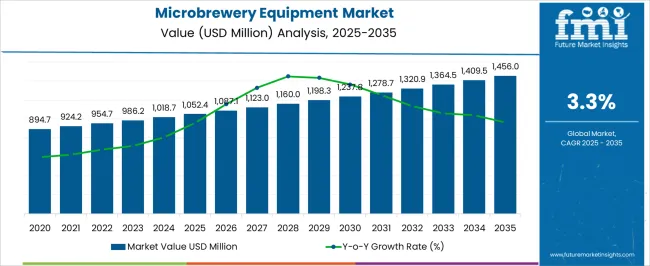
| Metric | Value |
|---|---|
| Microbrewery Equipment Market Estimated Value in (2025 E) | USD 1052.4 million |
| Microbrewery Equipment Market Forecast Value in (2035 F) | USD 1456.0 million |
| Forecast CAGR (2025 to 2035) | 3.3% |
The microbrewery equipment market is undergoing notable growth driven by increasing consumer demand for craft and specialty beers, coupled with technological advancements in brewing processes. A shift toward smaller scale, artisanal production has encouraged breweries to invest in specialized equipment that enhances product quality and operational efficiency.
Materials and automation technologies have become focal points for manufacturers seeking to optimize brewing cycles and maintain consistency. Future expansion is expected to be fueled by the rising number of microbreweries globally and increasing investments in process modernization.
The push for energy-efficient, hygienic, and scalable equipment solutions is creating avenues for innovation and market penetration. Partnerships between equipment suppliers and microbrewery operators are becoming critical for facilitating customization and after-sales support, further reinforcing growth prospects across various market segments.
The market is segmented by Product Type, Material Type, and Mode of Operation and region. By Product Type, the market is divided into Fermentation Equipment, Brew House Equipment, Carbonation, Control & Monitoring, Filling & Packaging, Mashing Equipment, Milling Equipment, Filtration System, and Fittings & Valves System. In terms of Material Type, the market is classified into Stainless Steel, Brass, Copper, Aluminum, and Mild S. Based on Mode of Operation, the market is segmented into Automatic, Manual, and Semi-automatic. Regionally, the market is classified into North America, Latin America, Western Europe, Eastern Europe, Balkan & Baltic Countries, Russia & Belarus, Central Asia, East Asia, South Asia & Pacific, and the Middle East & Africa.
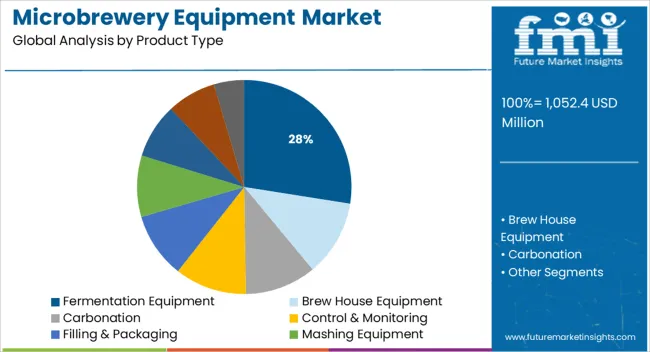
When segmented by product type, fermentation equipment is projected to hold 27.5% of the total market revenue in 2025, making it the leading product type. This prominence is attributed to its critical role in the brewing process where precise temperature control, contamination prevention, and fermentation consistency are essential.
The adoption of advanced fermentation tanks and vessels with integrated monitoring capabilities has driven efficiency and product quality improvements. The durability and adaptability of fermentation equipment to different beer styles have further solidified its market position.
Additionally, the emphasis on reducing production times without compromising flavor profiles has increased demand for innovative fermentation solutions, supporting its dominant share.
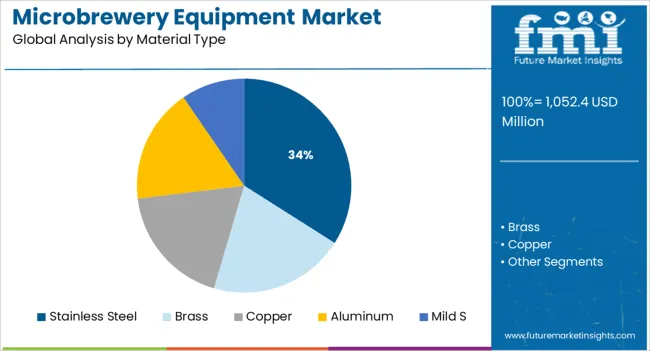
Segmented by material type, stainless steel is expected to command 34.0% of the market revenue in 2025, retaining its leading position. The segment’s dominance is linked to the material’s inherent corrosion resistance, ease of cleaning, and compliance with food safety standards, which are critical factors in brewing operations.
Stainless steel’s longevity and resistance to chemical reactions ensure minimal impact on beer taste and quality, making it the preferred choice among microbrewery operators. Furthermore, the material’s compatibility with automated systems and its ability to withstand high pressure and temperature have enhanced its adoption.
The growing preference for hygienic and durable equipment solutions has cemented stainless steel as the material of choice within the market.
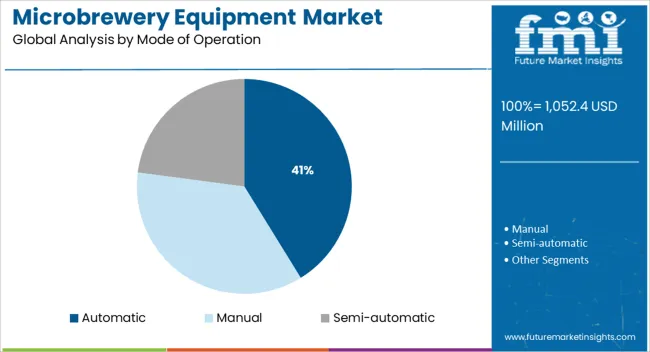
When segmented by mode of operation, automatic equipment is forecast to hold 41.2% of the total market revenue in 2025, establishing it as the leading operational mode. This segment’s growth has been driven by the increasing need for precision, efficiency, and consistency in microbrewery operations.
Automation reduces human error, enhances process control, and enables data-driven decision-making, all of which contribute to improved production outcomes. Equipment manufacturers have been investing heavily in automation technologies that facilitate real-time monitoring, remote operation, and integration with quality control systems.
The ability to scale production while maintaining product uniformity has further accelerated adoption of automatic modes. Consequently, automatic operation has become a critical enabler for microbreweries seeking to optimize resources and meet evolving market demands.
The global microbrewery equipment market is anticipated to grow by 3.3% CAGR between 2025 and 2035, in comparison to the 4.5% CAGR registered during the historical period from 2020 to 2025.
Growing demand for craft beer and the increasing number of microbreweries globally are some of the key factors driving sales of microbrewery equipment in the global market.
Similarly, the rising popularity of craft beer culture, especially across developed and developing nations like the USAIndia, Japan, China, Germany, France, and the UK is expected to bolster sales of microbrewery equipment during the forecast period.
A number of influential factors have been identified that are expected to spur growth in the global microbrewery equipment market during the projection period (2025 to 2035).
Besides the proliferating aspects prevailing in the market, the analysts at FMI have also analyzed the restraining elements, lucrative opportunities, and upcoming threats that can somehow influence microbrewery equipment sales.
The drivers, restraints, opportunities, and threats (DROTs) identified are as follows:
DRIVERS:
RESTRAINTS:
OPPORTUNITIES:
THREATS:
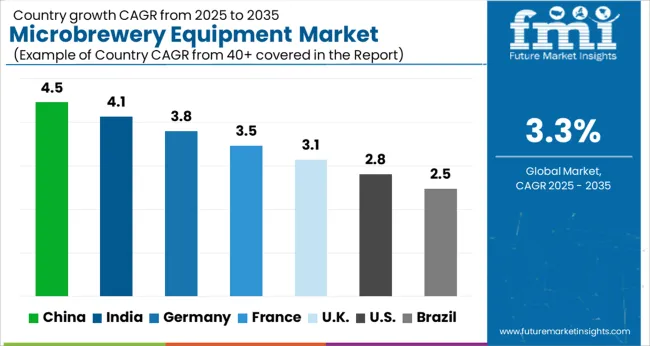
Growing Number of Craft Breweries Pushing Demand in the USA Market
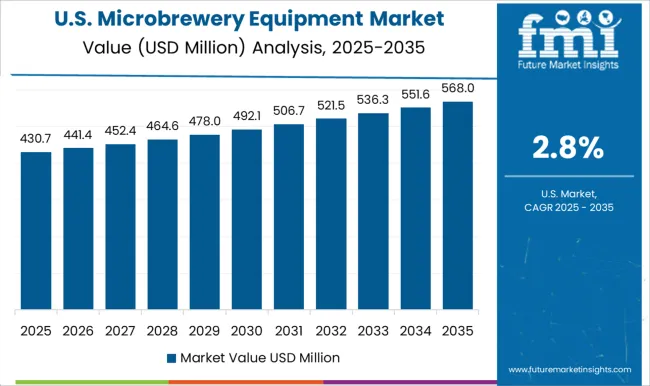
Currently, the USA dominates the global microbrewery equipment market and it is expected to grow at a steady pace during the next ten years (2025 to 2035).
Growth in the USA microbrewery equipment market is driven by the rising popularity of craft beer, the increasing number of microbreweries, and the availability of advanced beer-making equipment.
As the craft beer industry continues to grow in North America, so too does the market for microbrewery equipment. This includes both small-scale brewing systems for home and hobbyists, as well as larger commercial setups for professional brewers.
The demand for such equipment is being driven by both existing breweries expanding their operations and new entrants to the market.
According to the Brewers Association Annual Growth Report (2020), around 8,275 craft breweries were operating in 2020, including 2,058 microbreweries, 2,966 taproom breweries, 3,011 brewpubs, and 240 regional craft breweries.
This number is expected to further surge during the next few decades and will generate high demand for microbrewery equipment in the country.
Increasing Beer Consumption Boosting Microbrewery Equipment Market in China
As per FMI, China’s microbrewing equipment market is anticipated to expand at 5.7% CAGR during the forecast period (2025 to 2035), making it one of the most lucrative markets across East Asia.
Rising consumption of beer due to changing lifestyles, rising disposable income, and growing awareness about the potential benefits of beer are key factors driving the demand for microbrewery equipment across China.
In recent years, beer consumption has gained immense traction across China and the trend is likely to continue during the forecast period. According to the World Population Review, total beer consumption in China reached 9,533,441 gallons in 2024. This is playing a key role in elevating demand for microbrewery equipment.
China presents a huge opportunity for businesses that are looking to expand their operations due to several reasons. Firstly, the nation has a large population which creates a significant demand for goods and services.
Secondly, the country is experiencing strong economic growth, which is boosting household incomes and increasing consumer spending power. Finally, China has a young and dynamic workforce that is eager to embrace new technologies and ideas.
The microbrewing industry is rapidly expanding its use of automated beer-handling equipment to reduce production time and costs for greater efficiency and productivity.
The complex beverage production process necessitates constant monitoring, governance, and evaluation, which is easily accomplished with an automated brewing company setup. Although automatic equipment requires a large initial investment, it pays off quickly in the long run.
Beer-making equipment manufacturers are implementing novel strategies to increase sales and market penetration.
They are adopting a variety of strategies such as new product launches, mergers, collaborations, long-term partnerships, and facility expansions to increase their sales and solidify their positions in the global market. For instance,
| Attributes | Details |
|---|---|
| Estimated Market Size (2025) | USD 1052.4 million |
| Projected Market Size (2035) | USD 1456.0 million |
| Anticipated Growth Rate (2025 to 2035) | 3.3% CAGR |
| Forecast Period | 2025 to 2035 |
| Historical Data Available for | 2020 to 2025 |
| Market Analysis | USD Million for Value and Units for Volume |
| Key Regions Covered | North America; Latin America; Europe;Asia Pacific; Oceania; Middle East and Africa (MEA) |
| Key Countries Covered | USA,Canada, Mexico,Germany, UK,France, Italy,Spain, China, Japan, India,South Korea, Australia, Brazil, Argentina, South Africa, UAE |
| Key Segments Covered | Product Type, Application, Mode of Operation, Region |
| Key Companies Profiled | Alfa Laval; Kaspar SCHULZ; Krones AG; Praj industries; LEHUI; INTERPUMP GROUP S.P.A; Criveller Group; Della Toffola Spa |
| Report Coverage | Market Forecast, Company Share Analysis, Competitive Landscape, Drivers, Restraints, Opportunities and Threats Analysis, Market Dynamics and Challenges, and Strategic Growth Initiatives |
The global microbrewery equipment market is estimated to be valued at USD 1,052.4 million in 2025.
The market size for the microbrewery equipment market is projected to reach USD 1,456.0 million by 2035.
The microbrewery equipment market is expected to grow at a 3.3% CAGR between 2025 and 2035.
The key product types in microbrewery equipment market are fermentation equipment, brew house equipment, carbonation, control & monitoring, filling & packaging, mashing equipment, milling equipment, filtration system and fittings & valves system.
In terms of material type, stainless steel segment to command 34.0% share in the microbrewery equipment market in 2025.






Full Research Suite comprises of:
Market outlook & trends analysis
Interviews & case studies
Strategic recommendations
Vendor profiles & capabilities analysis
5-year forecasts
8 regions and 60+ country-level data splits
Market segment data splits
12 months of continuous data updates
DELIVERED AS:
PDF EXCEL ONLINE
Microbrewery Supplies Market Size and Share Forecast Outlook 2025 to 2035
Equipment Management Software Market Size and Share Forecast Outlook 2025 to 2035
Equipment cases market Size and Share Forecast Outlook 2025 to 2035
Farm Equipment Market Forecast and Outlook 2025 to 2035
Golf Equipment Market Size and Share Forecast Outlook 2025 to 2035
Port Equipment Market Size and Share Forecast Outlook 2025 to 2035
Pouch Equipment Market Growth – Demand, Trends & Outlook 2025 to 2035
Garage Equipment Market Forecast and Outlook 2025 to 2035
Mining Equipment Industry Analysis in Latin America Size and Share Forecast Outlook 2025 to 2035
Subsea Equipment Market Size and Share Forecast Outlook 2025 to 2035
Pavers Equipment Market Size and Share Forecast Outlook 2025 to 2035
Tennis Equipment Market Analysis - Size, Share, and Forecast Outlook 2025 to 2035
Galley Equipment Market Analysis and Forecast by Fit, Application, and Region through 2035
Sorting Equipment Market Size and Share Forecast Outlook 2025 to 2035
General Equipment Rental Services Market Size and Share Forecast Outlook 2025 to 2035
Bagging Equipment Market Size and Share Forecast Outlook 2025 to 2035
RF Test Equipment Market Size and Share Forecast Outlook 2025 to 2035
Medical Equipment Covers Market Size and Share Forecast Outlook 2025 to 2035
Telecom Equipment Market Size and Share Forecast Outlook 2025 to 2035
Welding Equipment And Consumables Market Size and Share Forecast Outlook 2025 to 2035

Thank you!
You will receive an email from our Business Development Manager. Please be sure to check your SPAM/JUNK folder too.
Chat With
MaRIA